Curing Salmon Roe
How to Make Caviar from Roe | Fish Eggs:
I have always loved caviar, the slight briny flavor of the sea with a unique texture of the fish eggs, first loose on your tongue, then the burst of flavor as each egg pops open onto your palate. There are not a lot of recipes or techniques that share how fish eggs are transformed into luxurious caviar. I’m sure you’ve looked this up on the internet and seen how to make fish eggs into bait. This is not the technique you want to follow if you want to consume the resulting fish eggs. This recipe teaches you the culinary technique of Curing Salmon Roe, transforming the fish eggs into caviar.
This is a culinary technique (or How To) that will become a wonderful base recipe, showing you the step by step process of transforming salmon roe (eggs) into caviar. If you or you have a friend or family member who fishes for Salmon, ask them if you can have their roe (only found in the female salmon). If this isn’t an option, contact your local fishmonger during Salmon season (in the month of May) and order some. Curing Salmon Roe is the same as making caviar. The roe comes in egg sacks, also called a skein. This recipe is designed for 1 skein but can be scaled to handle however many skeins | egg sacks as you have and can get your hands on.
This culinary technique can be used with all types of pacific wild salmon (King [Chinnock], Silver [Coho], Red [Sockeye], Pink [Humpy] or Chum [Dog]). Not that the name would make you think so, but Chum salmon has some of the best roe to make caviar, as their egg sacks or skeins are full-flavored and large in size. It is important to also know where your salmon came from if it is wild salmon vs farm salmon and the variety of the salmon. Check out this link on salmon to understand this topic more.
Recently I have been asked many times about freezing the caviar. While I have not tested this in this recipe, I have used frozen skeins | egg sacks before, to make this Curing Salmon Roe recipe. I would first thaw the skein | egg sack in the refrigerator for at least 24 hours prior to making this recipe. One could, after a successful fishing excursion, wash and dry the skeins | egg sacks and individually freeze them, removing as much air from the package as possible. This would simplify the making of a ton of caviar at once, and improve the quality of the caviar. Most commercial examples of caviar are very salty. This is what lead me to craft this recipe and the ratio of salt to the water, using less salt. Having less salt reduces the shelf life of this caviar, lasting a shorter period of time in the refrigerator. One can add more salt to the brine, knowing the end results will be saltier in flavor and taste.
A single salmon skein (egg sake) will weight around a pound and make about 16 ounces of salmon caviar. To get more information on wild Alaskan salmon, please check out our friends at Copper River Salmon.
If you love sushi and want to make your own ikura sushi, use this Curing Salmon Roe recipe to create your own ikura sushi.
Makes: 1 pound of Cured Salmon Roe | Caviar. This and all my recipes are scalable.
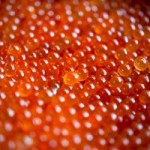
| Servings | Prep Time |
| 16 guests | 5 minutes |
| Passive Time |
| 30 minutes |
|
|

|
This culinary technique will teach you how to take fresh salmon roe(eggs) and turn it into amazing salmon caviar. Curing Salmon Roe will become your go to recipe for making homemade caviar.
|
- 1 each salmon skein or roe sack about a pound or other fish roe | eggs
- 1 cup salt, kosher do not used iodized salt
- 3 quart water warmed to 100°F | 38°C - 115°F | 46°C
- To begin: in a stainless steel or glass bowl large enough to hold 3 ½ quarts; add the kosher salt and 3 quarts of 100°F | 38°C degree to 115°F | 46°C water, whisking until the salt has dissolved. Next, unwrap the skein or egg sack if bought from a fish market or remove from the fish if you are a fisherman. Rinse the skein under cool running water, cleaning the sack of any residual blood.
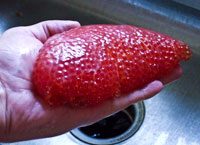
- You will notice a thin membrane that holds the roe in the sack.
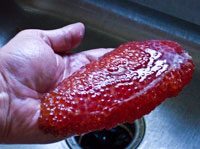
- Add the sack to the brine mixture.
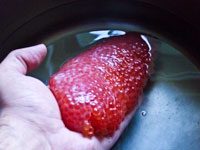
- When you add the skein to the salt brine, the membrane and eggs will turn from a clear reddish orange to a cloudy orange color.
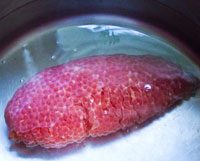
- This is the salt reacting with the membrane. Make sure that the skein is fully covered by the brine. Let this sit for 30 minutes, to cure the eggs.
- Have a second stainless steel or glass bowl ready with a strainer or small colander. After 30 minutes, remove the skein from the brine, reserving the brine for later. Add the sack to the bowl and rinse off the brine under warm water.
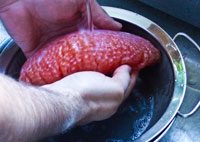
- Next, the membrane needs to be removed. Using your fingers, pick the membrane and pull away from you, making sure the skein is under the bowl and strainer.
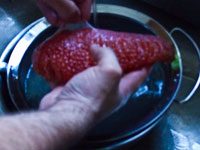
- Inside the sack are smaller membranes holding the eggs together. These also must be removed.

- Once all the membranes have been removed from the eggs, the eggs must be rinsed several times, to remove any other membranes that might be on each egg.
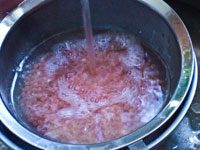
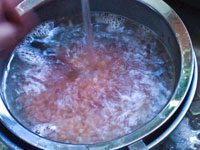
- A fine skimmer or other sieve will make this process.

- After you have removed all the membranes and rinsed the eggs well, drip the roe into the reserved salt brine again. The color of the eggs will turn from cloudy.
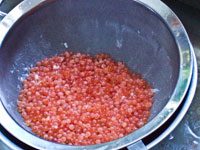
- To clear. It's like magic.
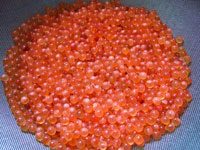
- Strain the eggs out of the brine and add to a clean glass jar. This caviar should last for 7-14 days if refrigerated at 34°F | 1°C or below.

- To keep the caviar as long as possible, place the jar into a container of crushed ice, keeping it colder than the standard refrigerator is set too. Do not freeze the caviar or the texture will be ruined.

- The resulting Salmon Caviar is transparent, bright, smells and tastes of the sea, with a light briny taste, that pops when the individual eggs burst on your palate.
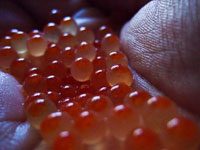
Curing Salmon Roe Variations and More Uses for this Recipe:
This recipe is simply a basic brine with not a lot of external flavor, other than the dominant essence of the salmon eggs. If you would like to add some complexity, try the Westmalle Tripel Cured Salmon Caviar or Firestone Walker Double DBA Cured Salon Caviar recipe. This caviar isn’t as salty as commercial caviars, which I prefer. Because of the lack of salt and curing of the roe, this caviar will only last about 2 weeks under refrigeration.
This culinary technique can be used on other varieties fish eggs | roe.




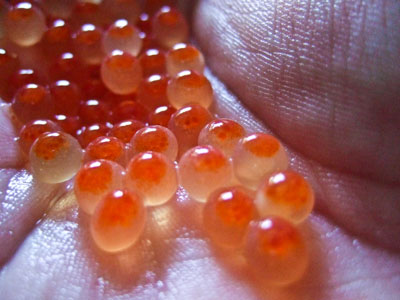

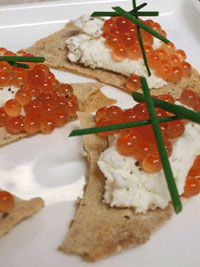

JUST MADE SOME, WONDERFULL!, I used eggs from Red Salmon taken from the Kenai river…. I love the wonderfully texture and light salt taste..
Thanks Arthur! I love this recipe and wish I had more access to whole salmon during their trip home…
Caught 3 chum salmon and 1 coho salmon in the last month on Mackenzie River. Just made some, taste so delicious! Now I know what to do with salmon eggs! Thanks for the recipe
Glad you found my site and recipe! Enjoy!
I have found that by chilling the fresh skiens and brining in cold water with or without salt,then using a sive colander to press or rake the skiens over the 1/4-3/8 in colander removes the membranes almost completely. Very little rinsing is required afterwards. I found the perfect colander at Save u More store on kbeach rd. in Soldotna. Ak. It works super with less rinsing. I like to prosses the eggs as fresh as possible.
To put a light smoke flavor to the cleaned roe . I will place them on a tray and smoke them lightly for about 30 min with low heat,using apple and alder chips. Good luck
Help, I froze the sock eye egg sack of roe as I cleaned the fish. Have I ruined the roe? Lydia in Idaho
Hi Lydia,
Your skein or egg sack should be fine, as long as there is no freezer burn. Thaw the egg sack overnight in the refrigerator and follow the recipe as described. Enjoy!
I enjoy this recipe so much that I took the chance and had some skeins frozen to cure later once back in the lower 48. I can attest that the recipe works (after slow thaw). Not as amazing as the fresh eggs but an option for the 10 months of the year you can’t get fresh salmon roe.
Can the now caviar be refrozen for later use?
Yummy
Help I cured my eggs but I thought it was 3 cups of water not 3 quarts….did I ruin my roe completely ???
Try remaking the recipe with the correct water amount.
i used 1 liter of water with half a cup of fine salt and it came out perfect! but clearing the water is a real bit.h. it took me like 45 min to get rid of all loose white stuff … ugghh
perfect taste ! THX!!!
Can anyone tell me if my husband who has had a heart transplant 18 months ago can eat salmon eggs using this recipe?
For the amount of caviar that your husband might eat at a sitting, I think it would be fine. This recipe uses less salt than store bought versions. If salt is a huge deal with his diet, I still would recommend talking to his Doctor.
Thank you
How in the world are you getting the eggs put of the sacs? I have tried this recipe at least twice. The sac WILL NOT peel away from the eggs, and if I try to scoop the eggs out with my fingers, half of them get mushed. What am I doing wrong??
Hi Kassia,
Are you seeing the eggs go cloudy? Your brine temperature should be 100F, and holding it at that temperature over time. Please let me know if that works.
Cheers,
Sean
I noticed you call for a medal or glass bowl for processing. Is there a Reason for using either bowls? What about plastic? Looking for your advice on bowl selection. Additionally, can you explain what iodized salt does to eggs?
Thanks for the message Carol. Yes, I suggest harder materials, such as stainless steel or glass for bowls. Plastic bowls can harbor odors and residue that is harder to remove because of the porous nature of the material. Plus plastic is much easier to scratch, causing a ridge that could cut the eggs or harbor bacteria that could spoil the eggs sooner and make them unsafe to eat. And the heat issue, as both metal and glass can be used over heat, plastic can not. These are the reasons why I suggest metal or glass bowls, when making caviar or for other cooking purposes.
Great recipe, but removing the membrane was a tough motherhubbard and some small bits still remain. Wish I had read the comments section first! We got a silver (Coho) off Discovery Par
k in Seattle yesterday, and it was a girl! We’ll enjoy it with some bread from Seawolf and lightly herbed homemade cream cheese.
I have used a wire mesh grill rack and drag the skeins over it. Eggs fall into a bowl below leaving a few threads of proteins to pick out by hand
Can you do the recipe with Himalayan pink salt? If you have double the amount of salmon eggs do you need to double the amount of water and salt?
Thanks for the comment Margaret! If you are wanting to process all the skeins at the same time, it is best to double the recipe, making a larger amount of brine. You can subsitute Himalayan Pink Salt if you wish. I like using sea salt, as the salmon (and eggs) come from the sea).
I just made this and it came out perfect! Gorgeous and the perfect amount of salt. I now have two ice cream pints filled with caviar 😂 Thank you for sharing!
So glad you enjoyed the recipe Anna! Adding more salt will make the caviar last longer, but the extra salinity makes for a saltier caviar too…
I just received a small jar of salmon roe from a friend. I believe it has been refrigerated for 3 days. The membrane was removed, but nothing else done. How long will it keep before I process it according to your directions. It appears to be very fresh, and I’m hoping I will be able to use it.
The sooner the better! Smell the eggs, they should smell of the sea, not fishy.
I always thought I had my homemade salmon caviar recipe down pat but the last batch of coho caviar I made turned out somewhat dry. The taste was fine but some of the eggs stuck together and didn’t seem to be as oily as they should be. Did i was them too much after brining or did I make some other mistake?
Thanks for your comment. It’s hard to be sure without tasting and seeing the results. It could have been the fish, it’s diet and freshness. It also could have been if the recipe wasn’t followed correctly. Hope this helps!
My wife has made a few batches of salmon caviar. The first cam out great, but the ones after have all gone rubbery after just one day. The only difference is, the first was i the skein, and the others had been separated by the store, However, before washing and salting, they were so delicate, as normal. But after salting and standing for a day, they were like little bullets! WTF went wrong?
Hi Kevin,
Bummed to read you story. I am not sure what went wrong. If the recipe was followed correctly, this shouldn’t have happened. I have made this recipe about 12 times now and never had this result. Were the eggs soaked long enough? The right salt? The right amount of salt? That is the only thing I can think of. Or that the eggs were treated from the store… My suggestion if making sure each step is followed to the letter. Please let me know if this helps.
Will the caviar be ruined if it is frozen afterwards?
Thanks for the great question Rocio! I have not frozen this or any caviar recipe before. It usually gets consumed before it even has a chance to go bad… Yet I think, especially with the curing process, that the caviar should be fine. Please try it and let us know your results!
Cheers,
Sean
It’s salmon season in the Pacific Northwest and we are overwhelmed with all the eggs… is there any way to preserve them for longer? We really don’t want them to go to waste!
Hi Dani!
I have used frozen skeins before, to make this recipe for caviar. I can attest to freezing the egg sacks and using them later to make caviar. just thaw the egg sacks in the refrigerator for 24 hours before following this recipe. Thanks for asking a great question.
Happy Curing!
Sean
My husband caught a female keta this afternoon. We immediately looked for directions to cure the eggs and this was the first hit. It took some convincing for my husband to wait on me to go out and buy kosher salt. But they came out awesome. Definitely not nauseatingly salty like store bought caviar is. Just right. And so easy.
Wonderful to hear Denise! That same reason, the overly salty store bought versions of caviar, lead me to this creation. Once I had this recipe it was hard for me to go back to store bought caviar. So glad you and your husband enjoyed!
Cheers,
Sean
I live on the coast in northwest Washington State and make my own salmon caviar but have always had to store it in my refrigerator, where the shelf life is relatively short. I know it can be frozen but this detracts from the quality and wonder if caviar can be canned, either by pressure cooker or hot water bath, and would that be the same as buying a very expensive vacuum sealing machine for jars or cans?
Got a sac or two from a load of chum we were gifted. Never made my own roe before. If a skein is compromised (like cut into already) will the result of putting the Im the warm brine still work?
Hi Sheryl,
I have not tried making caviar with a broken Skein, yet I don’t see why it wouldn’t work. The idea is to remove the egg sack | skein. Ruptured eggs is the only reason I would think that this recipe wouldn’t work. If you do try to make this recipe with what you have, please let me know how it turns out.
Cheers,
Sean
Oh My I do this then the trapist ale it is amazing.
It’s true – they went from opaque orange to clear red on the second dip, just like magic!
I was hesitant to try curing but your recipe was easy to follow and I love the lower-salt caviar. Thank you so much, I’ll never waste salmon eggs again!
Thanks, Sarah! Appreciate the trust and so glad to hear that the caviar turned out to your liking! Cheers!
I have read all of your responses Sean and it’s very clearly a winner recipe. However, my question is can you ‘water can’ the roe in this recipe for shelf use later? And does it have to be salmon roe?
Hi Lori,
Thank you for your kind words. I have not tried to water pasteurize the roe, if that is what you are asking. I would be careful as cooking the roe would change the texture of the final product. Freezing would be a better choice, in my opinion.
You could use a different fish roe if salmon eggs aren’t available. Depending on the size of the fish eggs being used, the brine time might need to be adjusted. Smaller eggs will cure quicker than larger eggs.
Thanks for the questions,
Cheers,
Sean
This looks like a killer recipe that I’d love to try. The last time I caught a salmon with eggs was a big coho hen in the Columbia. The four of us ate most of the eggs right out of the belly and downed it with some IPA. I live in Yokohama and frequently visit Hokkaido and do the same thing.